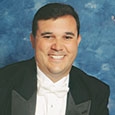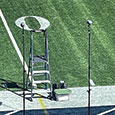With the first half of the school year behind us, the task becomes finding innovative ways to build on the successes from the first semester. When teaching beginning students, the goal is often to build confidence as they use recently learned skills. With more advanced groups, the challenge is to refine skills that have been mastered and take their musicianship to greater heights. Regardless of the level of the ensemble, I have found the following questions helpful for shaping rehearsals.
How do you get students to start together?
To get students to perform uniformly, I have used several methods throughout my career each with their own measure of success. One thing that each of these methods has in common is that they incorporate visual stimulation.
Key Toss
I recently conducted an honor band of nearly 150 students in a rather large gymnasium. Because the situation was not an intimate setting, I needed to enlarge most of my gestures and movements, including the size of my pattern. As I began the rehearsal, I observed that the ensemble rarely performed a clear downbeat, perhaps due to the large space the band covered. With limited rehearsal time to establish good fundamentals, a clean entrance was one of my top priorities. To demonstrate the importance of performing together, I took a set of keys from my pocket and asked the entire ensemble to clap when they expected me to catch the keys. At first, the clapping was mostly together, however it was still not as clean as I would like. We tried again a few more times and the students became more successful. I then asked the students to incorporate taking a breath as I tossed the keys in the air and when they clapped on the catch that they also say the syllable tah. This simulated the typical wind instrumentalist’s need to take a breath and articulate the beginning of a note. For the most part, the students had success from the initial trial. I then referred to the tip of the baton as my keys and the bottom of the conducting plane as simulating my catching the keys. We repeated the same exercise of having all of the students breathe in and then say tah when appropriate. The performance was better, but not as clean. With a few more repetitions, vertical alignment greatly improved.
Focal Point Conducting
While focal point conducting might be beneficial for ensembles having difficulty staying together, it does limit some of the aesthetic communication of the conductor. The use of focal point conducting, in which the ictus for each beat in a measure is in the same position, can be the next step in assisting students not only to begin together but also to continue to perform together throughout the work. The use of focal point conducting provides students a single stimulus to process showing where the pulse resides, improving the possibility of vertical alignment.
How do you teach awareness of chords and tuning a specific note in a chord?
With persistence and accurate training, teaching students how to identify their role in chords will provide tremendous returns with performance intonation. As directors, we frequently tell students that the third of a major chord is nearly 14 cents too high when referring to just intonation. Because of this phenomenon, the performer must lower the pitch accordingly. Training students to know that they are performing the root, third, or fifth of a triad can be achieved with assistance from the director.
Chord Awareness
To train young students to identify their role in a chord, the director can begin working on ear training once their students understand the construction and performance of scales. For a passage in which a student has trouble matching pitch, the director can play a drone of the tonic pitch. The student can then begin on that pitch and play a major scale (or minor scale if appropriate) to identify which degree of the scale their pitch is assigned. While this may take a moment for the director to set up, the idea that students will eventually develop the ability to identify what part of the chord they have will prevail.
Tuning Specific Notes
Once students know what part of the chord they possess, the possibility of achieving better intonation is heightened. The process can be assisted with a tuner or memorization of all of the adjustments necessary to achieve just intonation of each interval when compared to the tonic pitch. One of the most assured ways of teaching students independence is by training their ears through the manipulation of pitch.
One exercise to assist student ear training is to use an electronic keyboard on which the tuning can be manipulated for the first part of your warm-up exercises. Finding a chorale that employs mostly traditional chords is a good starting point. It is recommended that the director plays along or finds a student pianist who can play the chorale on keyboard along with the rest of the students. Once students can play the chorale and know when they are the root, third, or fifth of each chord, the director should begin to manipulate the pitch so students are able to make the necessary adjustments. Director guidance may need to take place at first, however as the students gain confidence and demonstrate proficiency, the director can eventually wean themselves from direct instruction.
How do you teach students to play good fortepianos?
In March 2016 I wrote an article for The Instrumentalist describing how to use string bowings to assist with wind articulations. The article suggested that the visual stimulation provided by the bow may assist wind instrumentalists ability to understand how to perform different styles of articulation. In many regards, performing a fortepiano uniformly may also be improved with visual stimuli.
Unifying the fortepiano through visual methods requires the conductor to describe how soon after the initial attack (at forte) should the performer then move to the softest part of the dynamic (piano). There are some instances where the piano portion of a fortepiano is desired sooner rather than later. To strengthen the ability on achieving a unified sound, I would draw some sort of representation or describe the fortepiano using a recognizable object.
For instance, if I wanted an immediate piano after the forte attack, I might describe the shape as similar to that of a stemmed wine glass (or other suitable object) that is on its side. Drawing this on the board I would emphasize the desire for the softer dynamic (piano) to be reached at a certain period of time close to beat one. In the case of the example below, the softer dynamic is reached before the up-beat of beat one.
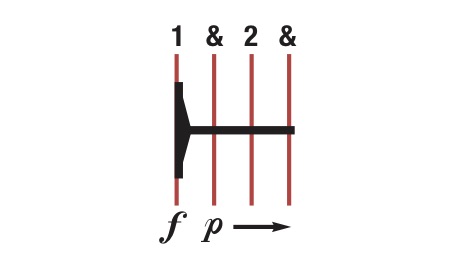
If I did not want a fortepiano to get to piano as soon, the drawing might resemble a funnel resting on its side.
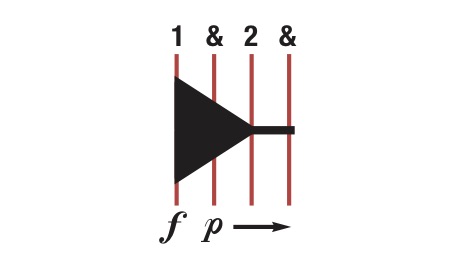
Although this method takes a few extra moments for the director to set up, uniform results throughout the ensemble are likely to happen sooner.
How do you differentiate between slurring and legato and between staccato and marcato?
A slur is performed with no interruption of air with the tongue. For brass players, simply changing fingerings without the aid of the tongue provides an appropriate slur. Woodwinds have a similar way to produce this through the addition or subtraction of keys pressed. String players simply perform a passage under one bow. In contrast, playing legato involves a slight, but gentle interruption of the air stream. Performing a gentle interruption is achieved through the use of different syllables when articulating. For instance, the following passage may use the syllable tah to achieve a more percussive or accented articulation.

To soften the articulation some, but not to the point of being legato, the performer can change the syllable to dah, which will provide a firm but less percussive articulation.

When slurring, as directed by the passage below, the performer would use no tonguing for those notes under the slur marking.

The syllable dah (in the above example) may be replaced with the syllable tah if the performer desires a more percussive and heavy beginning to each grouping.
Finally, a passage marked legato might be performed with a very gentle disruption of the airflow, when compared to slurring. For some the syllable doe might be a good starting point, but I prefer the syllable no when wanting to play with the least amount of interruption possible. Using the syllable no allows for the interruption of the airstream to be caused by the bottom of the tongue rather than the top, which better supports the idea of legato.
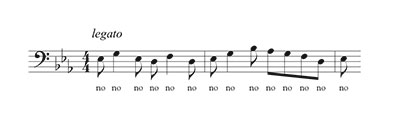
Because marcato would yield some residual sound after the attack, using a syllable that ends with –ah might provide enough of this residual. To help achieve a shorter sound associated with staccato, a syllable ending with t might provide the desired sound. Using the previous example, the following syllables might assist in the desired articulations and length of notes.
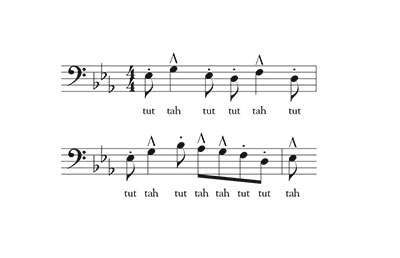
Conclusion
Finding creative ways to improve student performance requires meaningful communication. While the methods cited above have some degrees of success, continued favorable outcomes depends on how the director demonstrates these methods to the members in the ensemble. With careful persistence, methods that resonates with the students will have a tremendous effect on improving performance quality.
